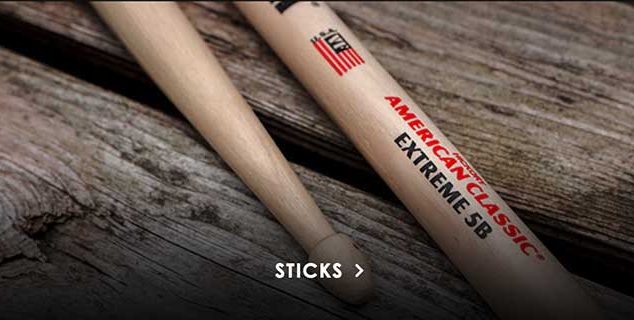READING MUSIC WITH WEBRHYTHMS:
LESSON EIGHT
Welcome to WebRhythms – an easy step-by-step method for learning to read rhythm, created by Vic Firth artist and educator Norm Weinberg. Starting at the very beginning, you’ll progress through 20 lessons, where each introduces a new topic. By the end of the series, you’ll be a master at reading rhythm!
In this WebRhythms lesson, you’ll learn about eighth note triplets. The exercise you’ll be working on in this lesson will include audio play-along tracks in five different levels that you can use to track your progress!
EIGHTH NOTE TRIPLETS
In this lesson, WebRhythms dive into new territory – triplets. At the most basic level, triplets can be defined as note values that divide a count, multiple counts, or a portion of a count into three equal parts. Make a mental note that the key word in that last sentence is “equal”.
To backtrack just a little, the notation system that we use in Western music isn’t well suited for dividing a unit of time into three equal parts. There are two half notes to a whole, two quarter notes to a half, two eighth notes to a quarter, and …well, you get the idea. You’ll remember from the last WebRhythms lesson that in a compound time signature such as 6/8 or 9/8, each major beat (the dotted quarter note) consists of three counts (three eighth notes). This is one technique of dividing a single beat into three equal divisions. But, how can you possibly use regular note values to split a quarter?
Unfortunately, you can’t. Instead of using “regular” note values, you must use something called “false notation”. Don’t let this nametag worry you; it’s really very simple to understand.
Take a look at example 1. In these measures, you see a few figures where three eighth notes are beamed together. These eighth notes are slightly different than normal eighths because they have the number “3” written above them. They are called eighth note triplets because they use the values of eighth notes. Normally, in 4/4 time, three eighths would have the value of one and a half counts. Now, because of the “false” notation, these three eighths have the value of a single count or a single quarter. It’s as if the number “3” above the triplet tells you: “We all know that three eighths don’t equal a quarter, but let’s make believe that they do.”

All types of triplets follow the same simple rule: three in the time of two. Even triplets that use different note values follow the rule. If you apply this formula, three eighth note triplets will have to be played in the same amount of time as two “normal” eighth notes (one full count in 4/4 meter). The difficult part in playing triplets is to make absolutely certain that all three notes are the same duration. We’ve previously discussed the figure of two sixteenths and an eighth, and the figure of an eighth followed by two sixteenths. In each of those figures, there are three strokes in a full count, but they are not of equal length.
Let’s have some fun and perform a “Mr. Wizard”-style science experiment. Look at the face of an analog clock (the ones with the numbers in a circular pattern). As you watch the sweep second hand make its circular journey around the face, you are going to snap your fingers when the second hand reaches particular numbers. Here’s the first experiment: Snap your fingers at the numbers 12, 3, 6, and 12. You’ve just played the figure of two sixteenths and an eighth (along with the downbeat of the second count). For the second experiment, snap at the numbers 12, 6, 9, and 12. This time, you’ve played the rhythm of an eighth and two sixteenths. I’m sure that you’ve noticed that the amount of time between each of the snaps was not the same. Now for the last experiment, snap on numbers 12, 4, 8, and 12. Presto! You have just performed a very slow (but rhythmically correct) triplet.
I know that it may seem like I’m beating a dead horse, but many musicians do not play triplets that are rhythmically accurate. There is something that you can do to help insure that all triplets you play will be as accurate as possible. Count!
As shown in example 2, there are several different counting systems that are used when counting triplet figures. Feel free to use the system you prefer, as long as you are consistent and say the same set of syllables every time you encounter triplets. I like the syllables “One-and-ah” or “One-la-le”, because they give you an indication of where you are within the measure (count one or count three for example). If you use One-and-ah, notice that you will say the same syllables for both triplets and the figure of an eighth and two sixteenths. You won’t be confused, as your common sense will tell you if you’re playing a triplet or a sixteenth-based figure.

Triplets offer a wide variety of musical expression to both the composer and the performer. The triplet’s main purpose is to briefly throw a rhythm that is in simple meter into a compound meter phrasing. As you take a look at example 3, notice that both measures will sound exactly the same as long as the speed of the beat remains constant from the first measure to the second (the speed of the beats, not the speed of the counts). In both measures, the first and third beats are divided into three equal parts. But, because the second measure is written in a compound meter, the eighth notes are not triplets.

Before getting to the exercise for this WebRhythms lesson, I’ve included a little “pre-exercise” that may come in handy. Set your metronome to sixty beats per minute. Now practice playing quarters, regular eighths, eighth note triplets, and sixteenth notes in various combinations. Start with a measure or two of each figure before going on to the next. When this gets comfortable, try playing only two counts of each figure, then one count. Next, mix and match the four different figures so that you can smoothly and easily flow from one division to another. Be sure to stay with the metronome, count out loud, and try to keep all the figures rhythmically accurate. When you reach the point where you can switch between all four figures in any order at any time, you’re ready to begin the exercise.

If you’ve been trying to follow the “right-hand lead” ideas that were presented in an earlier lesson, you may notice a slight problem with triplets. Since triplets contain an odd number of strokes, playing a single triplet will reverse your leading hand. If you begin playing a set of eighth note triplets on count one with your right hand, your left hand will land on the second count. This is okay. It’s better to simply switch leads for a few counts than to try and play triplet figures with anything other than alternate sticking.
Practice the exercise slowly at first, and then bring the tempo up little by little. Next lesson, we’ll cover two other types of triplet figures.
PRACTICE THIS EXERCISE WITH THE PLAY-ALONG TRACKS!





